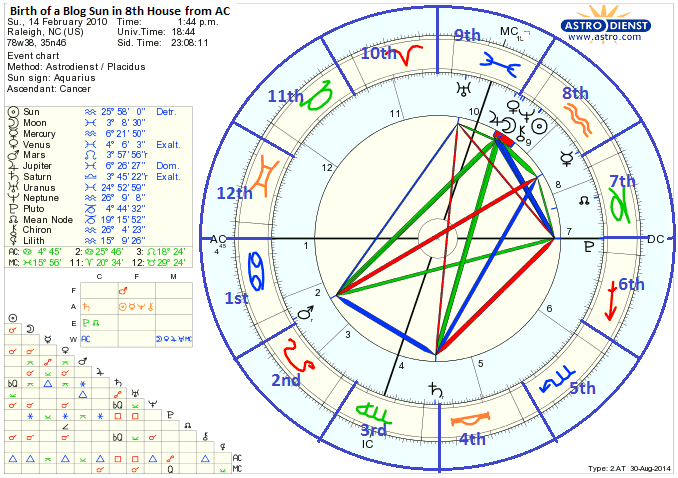Why Planets go
through the Last House First
Or- What are
Houses Anyway?
You might
wonder why Sun and the other planets go backwards through the houses; in other
words why is the 12th house the first place we see the Sun when it
rises? Shouldn’t it be called the first
house?
Actually houses are a relatively modern addition to astrology charts. The outer circle of the zodiac revolving around the inner fixed pie slices of houses did not become standard until after the Renaissance. The term houses comes
from the Greek word ‘topoi’ (Latin loci) which in old manuscripts could mean a couple of things.
In one usage, a planet was ‘located’ a certain number of signs from another planet; in the Birth of a Blog chart for instance, the Sun in Aquarius is the 7th sign from Mars in Leo, counting Leo as the first. This is usually translated as the Sun being in Mar’s 7th mansion or 7th house.
 |
| Sun in Mar's 7th house. |
The second way ‘loci’ is seen used is where we get the modern concept of fixed houses; locating a planet a certain number of signs from the ascendant, or AC as abbreviated in the chart. In the Birth of a Blog chart below, the Aquarian Sun is in the 8th sign from the Cancer AC (counting Cancer as the first). Another way to think of it is that Aquarius will be the 8th sign to rise after Cancer. We went from a sign being located 8th in line to ascend, in manuscripts before the Renaissance, to a sign covering the 8th house in the modern chart.
 |
| Equal House chart from Extended Chart Selection at Astrodienst |
Now we go from complicated to downright confused. If you scroll back up to the first chart, which is for the exact same time and place, you will see that it is not just a different format with a smaller circle, but that the houses are divided up differently so that the Sun is situated in the 9th house instead of the 8th. Remember we are talking about fixed houses now, where we count 30degree sections from the AC. They are called fixed because you will always see a little number 1 in the section just below the AC and the next one below will be 2 and all the way around to 12 for the section just above the AC. That much is certain, but the rest is a chaos of spherical trigonometry and ancient astronomy.
Choosing a House Division System
I used the Placidus system for 20 years, which is the one used in the small chart for Sun in Mar's 7th house. It divides the ecliptic into unequal quadrants according to the length showing to the east and west of the MC (midheaven). Because of Earth's tilt the ecliptic appears skewed to the east or west of the meridian for all but two small portions of our daily revolution. The MC line leaning to left or right reflects that phenomenon. If you think of houses as sections of the sky Placidus (and the many other similar systems) make a lot of sense.
It is a popular system, Placidus that is, and has been in use since the 1600's. I changed to the older Equal House system when I began getting a better idea of the mechanics behind the zodiac and what the houses actually stood for. I suspect the confusion arises from so many works handed down by writers that had little understanding of the zodiac, Ptolemny being the first example that comes to mind. But once again that's the opinion of a housecleaner.
Anyway, I like the small size of the Astodienst default charts, so most of my posts will have houses divided by the space oriented Placidus system, except for when I copy charts by hand and change the figures to Equal House. Here is an example of Equal Houses superimposed over the default Placidus.
 |
| Placidus chart with Equal Houses drawn over in blue. |
The thing to remember is that fixed houses originally indicated the order in which things appear above the ascendant. As soon as a planet or sign rises it goes to the back of the line and must follow the rest of the wheel around before it can show itself again on the eastern horizon. You will not run into the other use of houses in most beginner essays on astrology; but just in case you're not sure, a cue for the less common use will be a reference to a point or planet from which the houses are counted.



No comments:
Post a Comment